
The Russian Naval Infantry, often referred to as Russian Marines in the West, operate as the naval infantry of the Russian Navy. Established in 1705, they are capable of conducting amphibious operations as well as operating as more traditional light infantry.
The Northern Front was a front of the Red Army during the Second World War.
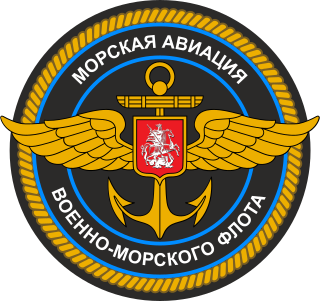
The Russian Naval Aviation is the air arm of the Russian Navy, a successor of Soviet Naval Aviation. The Russian Navy is divided into four fleets and one flotilla: Northern Fleet, Pacific Fleet, Baltic Fleet, Black Sea Fleet, and Caspian Flotilla.
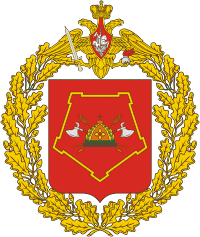
The Siberian Military District was a Military district of the Russian Ground Forces. The district was originally formed as a military district of the Russian Empire in 1864. In 1924 it was reformed in the Red Army. After the end of World War II the district was split into the Western and Eastern Siberian Military Districts. In 1956 the district was reformed. In 2010 it was divided between the two newly formed Central and Eastern Military Districts.

The Russian Space Forces are the space force branch of the Russian Aerospace Forces. Having been reestablished following August 1, 2015 merger between the Russian Air Force and the Russian Aerospace Defence Forces after the independent arm of service was dissolved in 2011.
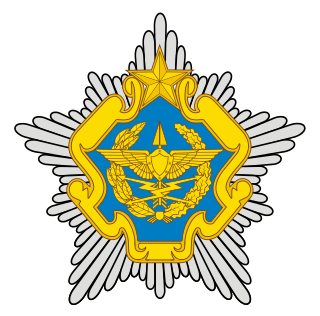
The Air Force and Air Defence Forces of the Republic of Belarus is the air force of the Armed Forces of Belarus, formed in 1992 from the 26th Air Army of the Soviet Air Forces which had been serving in the Byelorussian SSR.
The 18th Guards Insterburg Red Banner Order of Suvorov Motor Rifle Division, is an active division of the Russian Ground Forces.

The 6th Red Banner Leningrad Army of Air and Air Defence Forces is an Air Army of the Russian Aerospace Forces.

The Soviet Airborne Forces or VDV was a separate troops branch of the Soviet Armed Forces. First formed before the Second World War, the force undertook two significant airborne operations and a number of smaller jumps during the war and for many years after 1945 was the largest airborne force in the world. The force was split after the dissolution of the Soviet Union, with the core becoming the Russian Airborne Forces, losing divisions to Belarus and Ukraine.
The Leningrad People's Militia Army was initially an all-volunteer formation of the Soviet Union raised during the Second World War for defense of Leningrad.

The 45th Guards Spetsnaz Detached Brigade is a special reconnaissance and special operations military unit of the Russian Airborne Troops (VDV), based near Moscow. It was formed in 1994 as the 45th Independent Spetsnaz Regiment, and expanded to a brigade in 2015.
The Order of Lenin Moscow Air Defence District was a formation of the Soviet Air Defence Forces and the Russian Air Defence Forces, which existed from 1954 to 1998, to fulfill the tasks of anti-aircraft defence of administrative and economic facilities. The district administration was in Moscow.
The 55th Guards Rifle Division was a Red Army military unit, engaged in the Second World War. Its full name was the 55th Guards Rifle Irkutsk-Pinsk Order of Lenin, Order of the October Revolution, three Red Banner, Order of Suvorov 2nd degree division named after the Supreme Soviet of the RSFSR.
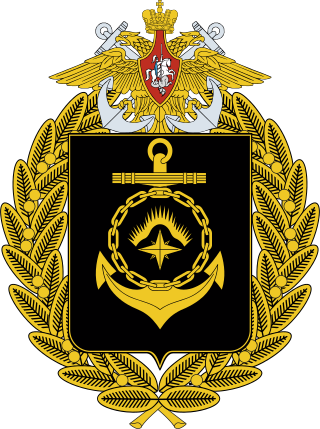
The Northern Fleet Joint Strategic Command, was a military districts of the Russian Armed Forces, with its jurisdiction primarily within the northern region of European Russia and the Arctic Ocean.

The Red Banner Central Asian Military District was a military district of the Soviet Armed Forces, which existed in 1926–1945 and 1969–1989, with its headquarters at Tashkent (1926–1945) and Almaty (1969–1989). By USSR Order No.304 of 4 June 1926, the Turkestan Front was renamed the Central Asian Military District.
The 17th Rifle Corps was a corps of the Red Army and later the Soviet Army, formed three times.

The 25th Red Banner Air Defence Division is a division of the Russian Aerospace Forces, part of the 11th Air and Air Defence Forces Army. Headquartered at Komsomolsk-on-Amur, the division controls S-400 surface-to-air missile and radar units covering Khabarovsk Krai and Sakhalin.
The following is a hierarchical outline for the Bulgarian People's Army at the end of the Cold War. It is intended to convey the connections and relationships between units and formations. At the end of the Cold War in 1989, the Bulgarian People's Army (BPA) reported to the Ministry of People's Defence (Bulgaria). The BPA included the Bulgarian Land Forces; the Air and Air Defence Forces; Navy; and Construction Troops.
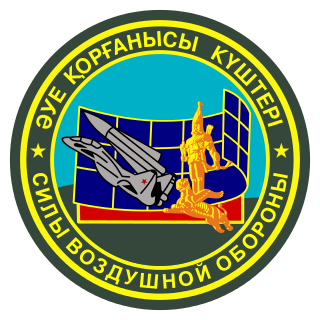
The Kazakh Air Defense Forces is the aviation warfare branch of the Armed Forces of the Republic of Kazakhstan. Their responsibilities include protecting Kazakh airspace, as well as combat missions in support of other branches of the armed forces. The official holiday of the air forces is Aviation Day on August 18.

The 1st Donetsk Army Corps is a military formation of the Russian Ground Forces as part of the Southern Military District, formerly a militia of the Donetsk People's Republic. It was officially incorporated into the Russian Federation on 31 December 2022, after Russia annexed the occupied territory of Donetsk.

















